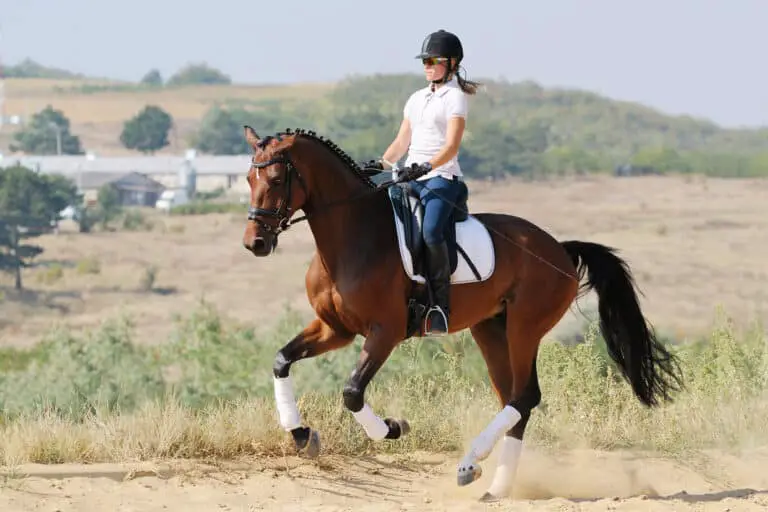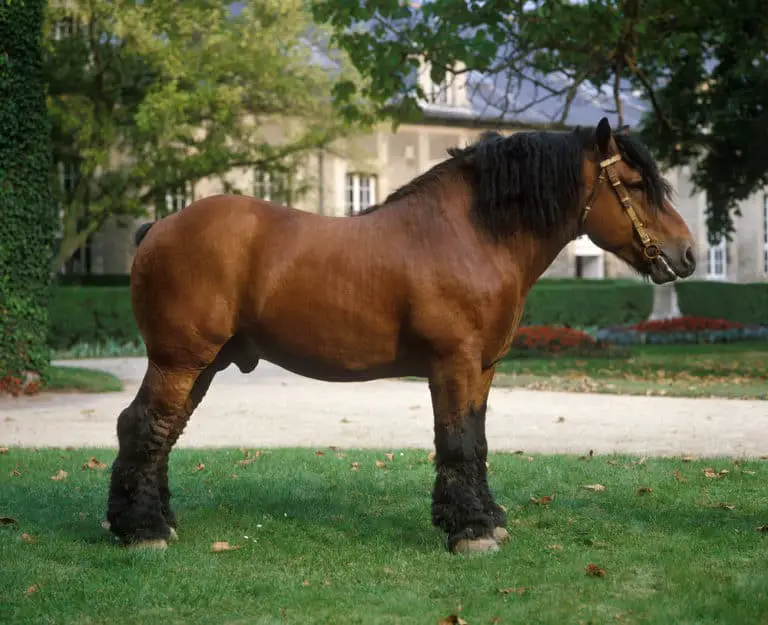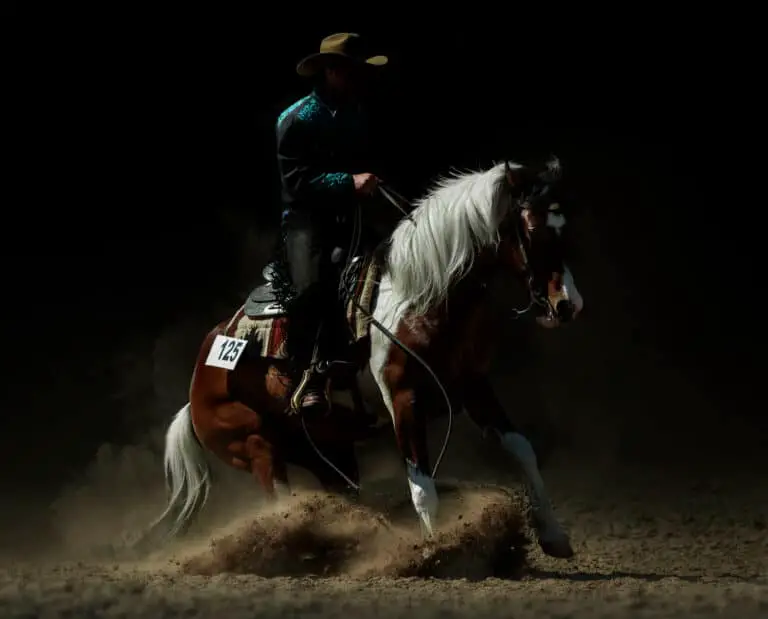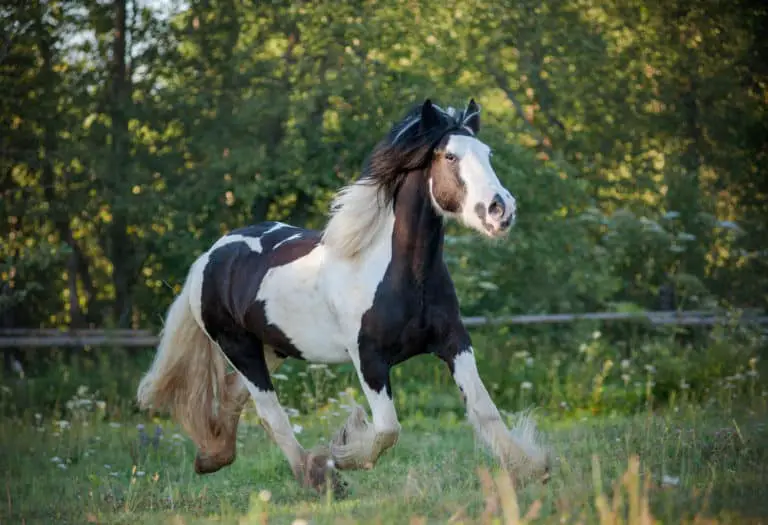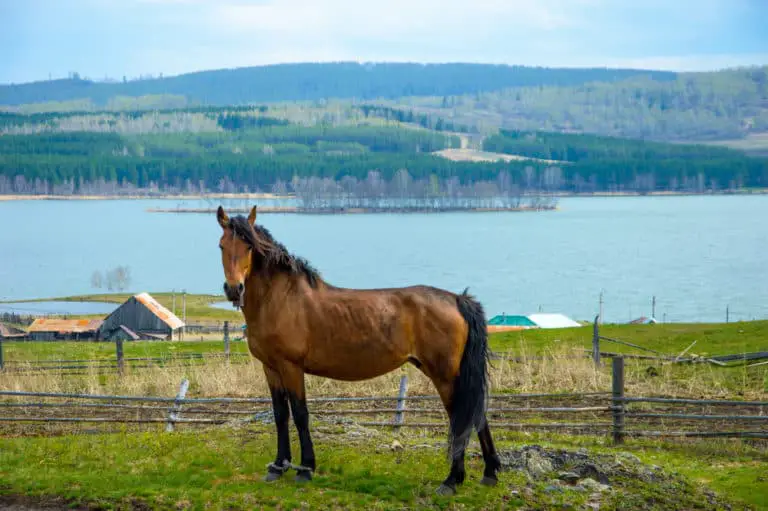Miniature Horse Breed: Care, Cost & History (2025)
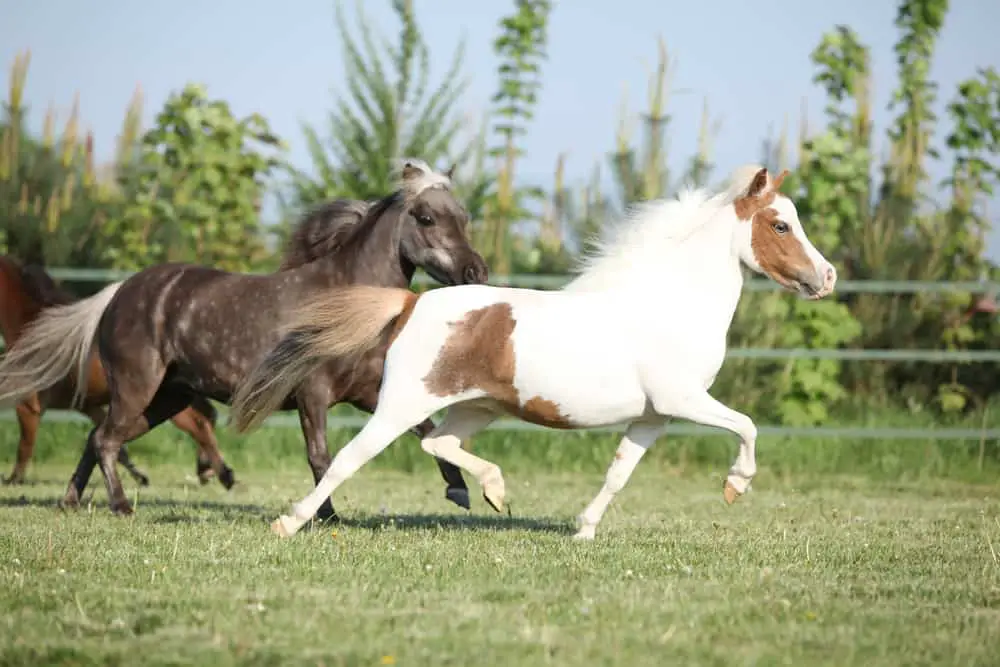
The Miniature Horse is a unique breed and has a special appearance due to its small size. Miniature horses are extremely tiny since they usually stand under 34 inches.
They are often smaller than large dogs. Still, they are considered horses and not ponies since they share the slim conformation of regular-sized horses and not the compact bodies of ponies.
Breed: Miniature Horse
Adult Weight: 200 pounds
Adult Height: under 34 inches
Origin: Europe
Use: As Pets, Driving
Colors: All colors
Features: Tiny size, thin and long legs, physical characteristics of a tall horse
Lifespan: 25-35 years
Character: Intelligent, curious, willing to learn
Gait: natural free-flowing, four-beat gait
Best for: Families, all level riders
- Characteristics
- Miniature Horse Care
- Miniature Horse History
- Modern Miniature Horses
- Cost and Ownership
- Buying a Miniature Horse
- Similar Breeds
Miniature Horse Characteristics
The most characteristic feature of Miniature horses is their size which is indicated already by the breed’s name. The Miniature Horse is a minimalistic version of a regular-sized horse.
Miniature horse characteristics are in every aspect similar to those of a tall horse breed, except for their height. Even the Miniature horse head resembles that of a tall horse and without a size comparison next to them, they could be mistaken for regular horses.
Size
The Miniature horse breed has several different breeding associations worldwide with different breeding standards regulating their size. The most popular breeding association, the AMHA, says that Miniature horse height must not exceed 34 inches measuring from the last hair of the base of the horse’s mane (1).
The Mini horse size is the most valuable factor for this breed and is the main criterion to register a horse with the breeding society. Another important breeding standard regarding their size is that the Miniature horse should have the physical appearance and features like a regular-sized horse and not those of a pony.
Weight
An average Miniature horse weighs around 200 pounds (90kg) (2). The Miniature horse weight is considerably lower than that of regular-sized horses which are weighing approximately 660 pounds (300kg).
Despite their small size, their body and all other physical features resemble a regular-sized horse. They weigh so little because they are a miniature version of a tall-sized horse which is the reason for their light weight.
The weight of the Miniature Horse is so moderate, that they are even allowed as assistance animals on flights or in shops. Due to their small size and light weight, they can not carry a child or a person and therefore not be ridden.
Colors
The American miniature horses appear in any coat color and can have various patterns (1). Furthermore, white markings and eye color are equally acceptable according to the American Miniature Horse Association.
Many other breeding associations of tall-sized horses do not accept markings, but seeing that the size is the most important characteristic of this horse breed, there are no limitations in regard to colors.
Miniature horse colors are therefore very colorful and one has a variety to choose from. The beautiful Miniature horse most often appears in bay, grey, black, gruello, and chestnut. Those colors are amongst the most popular colors for many horse breeds. Rare Miniature horse colors are champagne, cremello, and silver dapple.
Temperament
According to the American Miniature Horse Breeding Association, the Miniature horse temperament is reflected in its personality. Miniature horse behavior is characterized by their intelligence, curiosity, gentleness, sensibleness, and willingness to cooperate (1).
When it comes to Miniature horse training, the Mini horse is easy to train and often used for driving and equine shows.
Even though the Miniature horse can not be ridden and therefore not compete in dressage, they are an often seen horse breed in many equestrian shows and will participate in driving activities.
They must be trained and treated like any regular-sized horse since they also show the flight-fight behavior that is typical for horses.
Miniature Horse Care
The Miniature horse lifespan can be even longer than that of tall horses with up to 35 years. To achieve such a great age for your Miniature horse, you must care for it patiently and extensively.
There is a lot of care to provide for when it comes to owning Miniature Horses. The Mini horse breed has any need, a regular-sized horse has. Furthermore, they are prone to gain weight and they are susceptible to some health problems due to their small size.
Diet and Nutrition
The Mini horse diet is not generally demanding when it comes to nutrients and supplements, but you will have to strictly regulate the amount and calories for your Miniature horse since they are prone to obesity.
Miniature horses do not need a lot of food due to their small size. The amount of their diet should be consistent with 1% of their body weight.
Before you calculate this amount, you must make sure that your horse has a healthy weight (2). The small horses need a variety of pasture, fresh hay, some grain and vegetables, and fruits.
Health Problems
Since the main breeding goal of Miniature Horses is their very small size which is achieved by breeding, the Mini horse can have quite a few health issues.
This is why most breeding associations demand a DNA test to exclude possible health problems to be passed along amongst registered horses.
When it comes to genetic problems, dwarfism is the most serious concern amongst breeders and owners. Dwarfism is a by-product of breeding small horses and is a widespread phenomenon within the Miniature horse breed.
Dwarfism is not sought for nor appreciated by breeders since horses with dwarfism can have very serious health problems like scoliosis, depression, and arthritis (3).
Grooming
Mini horse grooming is quite straightforward. Miniature horses must be groomed daily to maintain their general health and bond with your pet.
You should wash and dry your Mini horse stallion at least every 3-4 weeks. Otherwise, you and your horse might have to deal with skin infections and irritation.
Brush the coat of your horse every single day with a body brush to clean it from small particles and to strengthen your relationship (3).
Use a Curry Comb to remove more serious dirt and grease from the coat and to stimulate the blood flow.
Miniature Horse History
Interestingly, the Miniature horse history is strongly tied together with that of the Shetland Pony and European horses. Small and miniature horses became popular during the late 1900s and they have a gnarly history of being used for coal mining as pit ponies.
Enduring the hardness of working in the rough environment of mines, they nowadays enjoy a comfortable life as pets.
Origin
The American mini horse has their origin overseas in Europe. The first documentation of a miniature horse was that of a Shetland Pony that was imported into the United States in 1888 (5). We know that the first Shetland Ponies were imported into the United States in 1861 by John Rarey.
The Miniature horse origin most likely is located in Britain and the Netherlands. Dutch and English ponies are said to be the ancestors of the Miniature horse which was specifically bred in the United States to be even smaller than those first horses arriving in New England.
Historic Development
The Miniature horse had to endure a rollercoaster ride when it comes to its part in history. First, they were used as pets for the nobility from the 1600s until the early 1700s. When the use of children for mining has been prohibited, the former comfortable life of many Miniature horses has ended and they had to endure hard years as pit ponies in England (5).
In the late 1900s, the imported horses from Europe began to be admired by many Americans and breeding those tiny horses became popular again. Using pit ponies for coal mining was forbidden until the mid-1990s. Since then they are nowadays used as pets.
Notable Miniature horses
Since we know that Miniature Horses have been kept by novelty for many centuries and they are nowadays used for shows and driving, Miniature horse pedigree of some horses is well documented and still exists.
Some of those famous Miniature horses hold records for being the smallest horse on the planet or for being very accomplished at driving.
Einstein
Anyone who has been to the Oprah Winfrey Show can be considered a celebrity and so can the Miniature Horse Einstein. Einstein is an itsy-bitsy horse with a height of standing 20 inches tall. He weighs roughly 47 pounds and became a social media celebrity due to his cuteness.
Pea
Pea is the smallest horse in the world and he is a rescue Miniature horse. He is only 16.5 inches tall and was born with dwarfism. He was so small, that he couldn’t reach his mother’s udder and was supposed to be euthanized due to his several health issues. Pea was rescued by a kind-hearted soul and lives a happy life now.
Shammy
Shammy is a Miniature horse with dwarfism and lives in Georgia. He is only a little over 20 inches tall and has a very loving side. He became an internet celebrity with over 5000 facebook fans quickly. Shammy even has his own book and many visitors who want to see him.
Myths and Legends
There are some Miniature horse legends and myths which have been proven wrong by modern science and others proved to be true. The small horse breed has been appreciated by kings like Louis XIV of France and was thought to be an Eohippus. Nowadays many Miniature horses have become social media stars.
Eohippus
The ancestor to all horse breeds has been the Eohippus, the first horse on Earth. The Eohippus was also called the dawn horse and was an extinct group of mammals. They flourished in North America and Europe during around 56 million to 33.9 million years ago. Many thought, due to their tiny size, that Miniature horses might be directly related to the Eohippus, but this has been proven wrong by science.
Miniature Horses in Versailles
Louis XIV of France contributed a lot to Miniature horse history since it is documented that the French king kept mini horses in his menagerie at Versailles during the 1650s. He is a great example of a person of novelty who was keen on miniature horses that have been bred specifically to be kept as pets.
Pony or Horse?
Technically, any horse under 14.2 inches will be classified as a pony. But since many Miniature horses display a typical horse phenotype with typical features like long and thin legs, they are classified rather as horses and not ponies.
Modern Miniature Horses
There are many different types of Miniature horses since the breeding regulations mostly focus on their size and legs, rather than coat colors or patterns. The mini horses appear in all shades and colors but have limited uses for riders since they can not be ridden.
The modern miniature horse is mainly kept as a pet and can be used for driving as well. They are a popular pet for many people and children adore them.
Breeding
Mini horse breeding has become popular worldwide since the 1900s. There are two main breeding associations: the AMHA (The American Miniature Horse Association) and the AMHR (The American Miniature Horse Registry). The AMHA was founded in 1978 and the AMHR a little earlier in 1972.
Miniature horses breeding focuses on the size and height of the horses. According to the AMHR breeding regulations, “Miniatures are between 34″ and 38” tall. Unlike the majority of most equine breeds, miniature horses are measured at the last hair of their mane rather than at their wither.
Miniature horses come in a full spectrum of coat colorings and patterns and (unlike Shetlands), a spotted appaloosa is an accepted and popular coloring in the American Miniature Horse Registry.” (6).
Population
Even though the Mini Horse is so popular worldwide, the Miniature horse population is not well-documented. The biggest breeding societies are located in North America and Europe.
There are currently 9 Miniature Horses for sale on E-horses.com and 8 of them are located in Germany (7).
It has also to be noted that many Miniature horses suffer from dwarfism due to the extensive breeding and inbreeding to achieve very small horses which result in many Miniature horses with this disease not being officially registered. There is no current number of Miniature horses available or published regarding their population.
Uses
Miniature horse uses are limited compared to those of regular-sized horse breeds. Since mini horses are extremely small and light, they can not carry adult riders and even children can only be carried by the mini horse if they are young and very light.
They are most often kept as pets and can even be housetrained. Some owners take them to show competitions where they let the horse demonstrate their physical features or their capabilities to drive or pull small carts.
The Miniature horse gait is regulated and described by the AMHA saying that their walk is a “natural free-flowing, four-beat gait with a length of stride proportional to the height and length of leg.” (1). Their trot is naturally forward and free-flowing with a two-beat diagonal, “where the knee and hock are synchronized in their elevated, flexed and extension movement.”.
Miniature Horse Prices
When it comes to the Miniature horse price, many people only think about the actual purchase price of the horse.
But owning a horse comes with monthly and regular costs that can’t be avoided or skipped.
Once you have purchased a Miniature Horse, you will need to pay for monthly ownership costs which include boarding, feed, vet care, and hoofing care.
Purchase Price
Even though the Miniature Horse is a popular breed and is worldwide used as a pet, it is not as easy to get your hands on them compared to purchase other pets like dogs or cats. This is probably because the Miniature horse needs more upkeep than a dog and keeping them as pets is a new trend.
The pedigree, health status, and physical data determine the price of your Miniature horse.
The average Mini horse gelding costs between $1,000 to $5,000 (7). An unregistered Mini horse foal can cost as little as $200, but you should be aware that the common genetic disease of dwarfism sometimes only shows when the horse matures.
Ownership Costs
It is essential that when you decide to buy a Miniature horse, you are aware of the Miniature horse cost of ownership that comes with owning your horse. And that is aside from the initial Mini horse price.
The monthly costs of ownership should be taken into consideration: board, feed, veterinarian care, and hoof care are just some of the regular costs which can easily be as high as $1,000 a month.
Board
The Miniature horse board cost will be around $300 monthly (4). If you pay for full board, which includes regular vet care, feed, hoof care, and exercising your horse, the monthly boarding cost will be higher, around $550.
You could also house-train your Miniature horse and avoid spending boarding costs, but studies have shown that Miniature horses that are kept outdoors, usually live longer and are happier.
Feed
When it comes to Miniature horse feed cost you have to pay for high-quality hay. A bay of hale will cost you around 2$-$4. Horses need about 15-30 bales per month, but your Miniature horse will need less around 2-4 pounds of forage a day (2).
Be aware of overfeeding your Miniature horse since they can be prone to obesity.
Veterinary Care
The Miniature horse veterinary cost will be around $1,291 a year if nothing out of the ordinary occurs (4). These costs cover annual vaccinations, the farrier, insurance, deworming for 12 months and teeth floating once or twice per year.
Anything unexpected like injuries, inflammations, or colics is not included in this estimate. Keep in mind that you have to watch out for obesity. If your horse is obese or suffers from dwarfism, you will be confronted with significant and unexpected costs.
Hoof Care
The Miniature horse hoof care cost is regular since you need to shoe or trim their hooves regularly. Trimming your horses’ hooves costs around $346, front shoes cost $650 and a full set of shoes costs up to $1,300 a year if the farrier comes roughly every 6 weeks (4). This brings the annual costs to anything from $346 up to $1,300 a year depending on your Miniatures hoof care.
Buying a Miniature Horse
If you have decided to buy a horse of the Mini horse breed you already know that you will need to watch out for dwarfism and the mini horses can not be ridden.
Make sure to meet your Miniature before the purchase as the character of the horse should match your energy and what you are looking for. Your Miniature should always come with documentation and health certificates. If you buy a Miniature foal, a DNA test might be advisable to clue out dwarfism.
Is the Miniature horse Right for You?
The American miniature horse is a cute and great companion for Young and Old. Even though, riding a Miniature horse is not possible since the tiny equines can not carry most children and never an adult, owning a Mini horse can be a delight.
The Miniature horse makes a wonderful pet and can be a kind-hearted addition to your family. They need all the care a tall horse needs as well, so anyone keeping a Mini horse needs a lot of time and must be able to afford the regular expenses. If you are looking for a horse that will be held as a pet, the mini horse is a great choice.
How to Buy a Miniature horse?
If you are buying a Miniature horse you will need to look for a renowned and recommended Mini horse breeder. Visit the breeder to get an idea of how the Minis are brought up.
Look out for cleanliness in the stables, how many horses there are on the farm, and how the horses interact with their current owner.
Does the relationship seem loving and trusting or distant?
You should interact with the Mini of your interest and talk with the breeder about the traits and character of the horse to see if it is a good fit for you. Watch out for dwarfism in the horse and its relatives, since dwarfism can be a burden for you and the horse. If the breeder encourages dwarfism, this is a red flag.
Similar Breeds to Miniature Horse
There are some similar breeds to Miniature Horses that share some of their distinctive features. Mini horse breed alternatives are the Shetland Pony, the Falabelly, and the Guoxia.
Some of those breeds are slightly taller, of an exotic origin, or more suitable for riding and therefore offer good alternatives to a Mini Horse.
Shetland Pony
The Shetland Pony is probably the best alternative to a Miniature Horse if you are looking for a small and healthy horse, that you can even ride. Children and very small adults are able to ride Shetland Ponies and they are considerably healthier than a Mini horse. The biggest difference to a Mini horse is that Shetlands are a little taller and considered Ponies, not Horses.
Falabella
The Falabella is a small pony from South America. They are amongst the smallest horses worldwide and are categorized as ponies, which is why their bodies resemble those of ponies and not of horses. They are 25-34 inches tall and generally healthy.
Guoixa
The Guoixa Horse is an ancient miniature horse breed from Southern China. The breed is exotic and rare but resembles other pony breeds worldwide. The purebred pony can be ridden by children and is good-natured, quiet, and friendly. Wealthy families in China have Guoixa ponies as pets or for small children.
FAQ
What is a Miniature horse?
A Miniature horse is a small horse originating from Europe.
What does a Miniature horse look like?
Miniature horses are characterized by their small size, standing under 34 inches, but looking like a regular-sized horses otherwise.
How did the Miniature horse get its name?
The Miniature horse got its name because of its minimal size.
Can you ride a Miniature horse?
No, you can not ride a Miniature horse.
Are Miniature horses good for beginners?
Miniature horses are kept as pets and therefore all-level riders can keep them.
How tall is a Miniature horse?
Miniature horses must stand under 34 inches to be recognized as Miniature horses.
How much does a Miniature horse weigh?
An average Miniature horse weighs 200 pounds on average.
How big is a Miniature horse?
Miniature horses are very small but have the body built and appearance of a regular-sized horse.
How much does a Miniature horse cost?
A miniature horse can cost between $200 to $5,000.
How much does Miniature horse ownership cost?
Miniature Horse ownership costs on average $800- $1,200 a month if you pay for board, veterinary care, feed, and the farrier.
How long do Miniature horses live?
Miniature horses can live up to 35 years if they are kept outdoors.
How fast can a Miniature horse run?
The Mini horse can run between 18 to 20 mph (29 – 32 km/h).
How much can a Miniature horse pull?
Miniature horses can averagely pull their own weight, around 200 pounds.
How much can a Miniature horse carry?
Miniature horses can carry up to 20% of their own weight, which is why they can not carry adults, but only light and young kids.
At what age is a Miniature horse full grown?
Mini horses are fully-grown at the age of 2-3 years.
What are Miniature horses used for?
Miniature Horses are used as pets.
References
- The American Miniature Horse Association. 2022. Breed Standard. Link
- Michigan 4-H Miniature Horse Committee.2009. Feeding the Miniature Horse. Link
- New Scientist, Georgia Mason. 1994. Science: Grooming reaches the parts. Link
- Equine Guelph. 2022. Annual Horse Expense Sheet. Link
- The American Miniature Horse Association. 2022. About The Breed. Link
- American Shetland Pony Club. 2022. The American Miniature Horse – Unique…Interesting…Versatile…A Class All of Its Own! Link
- Ehorses. 2022. American Miniature Horse Prices. Link

